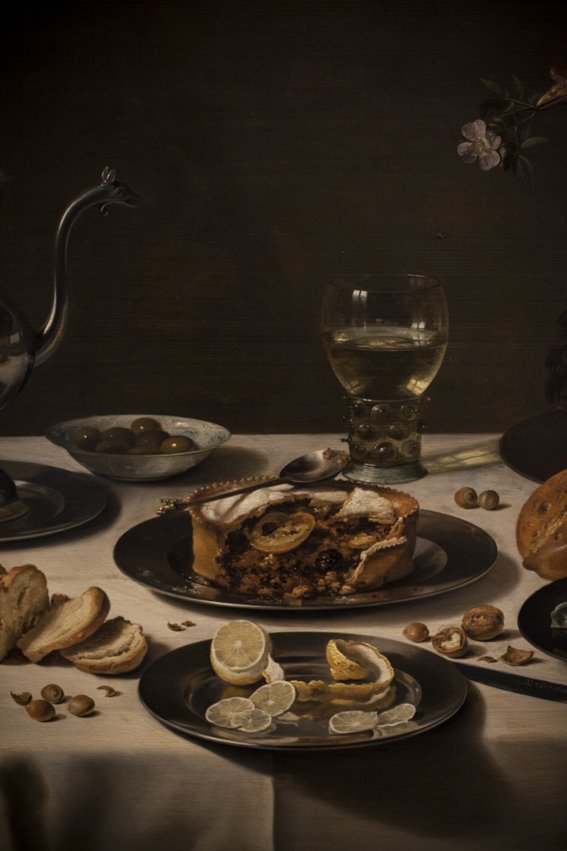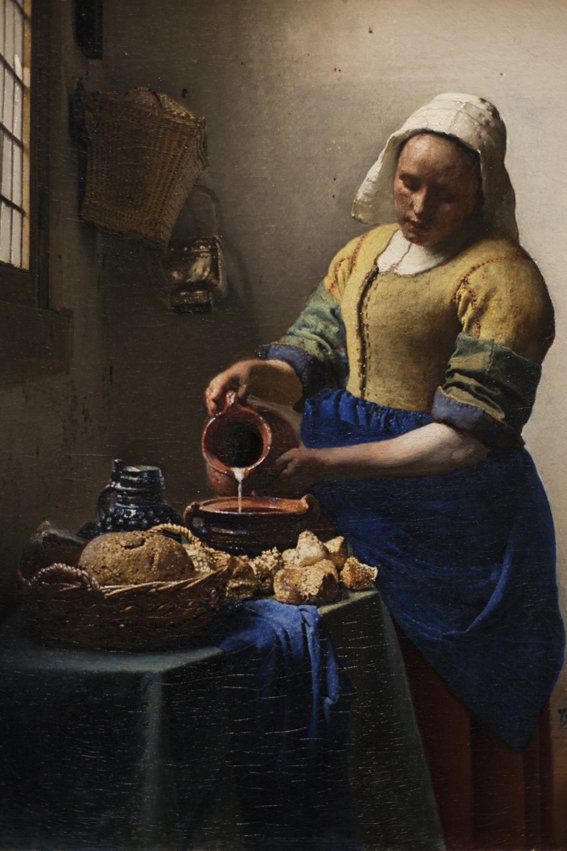Dutch apple tart inspired by Flemish paintings
& About looking - a eulogy to slowness
Although it wasn't my first time at Rijks museum, I allowed myself a different time to look, to go beyond the surface, back in time, to the eyes of those artists who laid their gaze - I imagine for so many hours - on those canvases, and before that on the incredible Dutch light, to understand it and report it in such realistic way.
I think about the time that perhaps a young Vermeer spent in the shady rooms of some shed-roofed house in Delft, watching how the late afternoon light gave an almost sacred aura to all those simple gestures of everyday life, which had never been told.
Precursor of photography, of the suspended gesture - that pouring milk, today trend on Instagram -, Vermeer not only looks at things with an extremely contemporary look, but his eyes - and with his own also those of many other Masters of the same century - look at the detail beyond the form.
Their glance goes inside things, inside the bodies of the men they painted as if they held their breath, inside the eyes of the animals that reflect the world around them, and sometimes even inside food, revealing its secret ingredients.
I find myself looking at an incredibly inviting apple pie, which appears in several paintings as if it had been the culinary trend of the time. In the filling, I get to see pine nuts, raisins, walnuts, and orange peel. The pastry seems fragrant, and freshly baked, and I wish I had a slice. When I get home I will make one, I think.
The crowd of people who push to take a picture of the paintings distracts me.
I wonder if the desire to photograph them today is a desire for possession. In my case - I don't refrain from doing the same - yes, it surely is. I don't know if mine is a real desire to understand, or simply eagerness to accumulate, making - in my own way - immortal a scene that in itself has already been made immortal by the author who made it.
I decide to avoid overthinking it, and paradoxically and a bit also by habit, I post some pictures on my Instagram stories as well. I often look impatiently, too, jumping like a grasshopper from one image to another, and I wonder how this quick way of looking affects (my) our collective visual imagery.
Is this perhaps the reason why the Masters of painting like Flemish ones no longer exist? Are there still eyes in the world that are able to see that way? How much the eyes like Vermeer’s have seen, and for how long? Could this be the point of it all, just a matter of time?
I'm still far from understanding, I think. Maybe I am also out of time.
Society teaches us that it is necessary to be productive and fast. Maybe that's why sometimes I don't feel I belong at this time.
I try it, but I also claim the right to do things slowly, to look with patience, inside things like Vermeer and the Flemish masters of the laid tables, who after 400 years still amaze us for having been able to look beyond time, the divine that permeates light, showing it to the world. Inside that little stuffed apple tart that seems to enclose a whole universe.
DUTCH APPLE TART
Ingredients:
For the crust:
360 g unsalted butter, cubed, room temperature
240 g brown sugar
Pinch of salt
2 eggs + 1 yolk
600 g self-rising flour
For the filling:
8/10 firm apples - 5 Pippin quality and 5 Gala or Golden Delicious or Pink Lady
Finely grated zest of ½ orange and ½ lemon
½ lemon juice
80 g brown sugar
2 tsp cinnamon
2 tsp cornstarch
1 shot (30 ml) Cognac, Brandy or Marsala
125 g sultanas
125 g chopped walnuts
100 g pine nuts
Instructions:
Preheat the oven to 180°C.
In the bowl of a food processor, mix the butter and brown sugar together until creamed. Sprinkle with the salt and add 2 eggs, the yolk will be used to brush over the pie later. Pulse until the eggs are well-incorporated.
Add half of the flour, and pulse until well incorporated. Then add the remaining flour little by little and pulse only until the dough comes together into a ball. Wrap it into the plastic wrap, and let it rest at room temperature while you prepare the filling.
Peel and core the apples, then cut them into small-size pieces.
In a bowl, mix the apple pieces with the orange and lemon zest, lemon juice, brown sugar, spices, cornstarch, liqueur, sultanas, walnuts, and pine nuts. Keep aside.
Grease a large, cake pan (I use a 22 cm pan), and cover the bottom with parchment paper.
Reserve 1/3 of the crust mixture for the pie’s topping. Pour the rest of the mixture into the pan and firmly press the dough against the bottom and all the way up the sides of the cake pan, till you have completely covered it up to the edges.
Add the apple filling and press down to compress and make it as flat as possible on top. You should keep around 1 centimeter in height from the filling's surface to the surrounding crust edge.
Using a rolling pin on a floured wooden board, roll the remaining crust mixture to get a round sheet (approx. 5-6 mm thick) with the dimension of the cake. Gently lift it with your hands and put it down over the apple filling. You can use first your fingers and then a fork or a toothpick to merge the two edges of the crust, into a single zig-zag unified edge all around.
Brush the cake surface with the yolk, then bake in the oven for 60 minutes. Start watching over the pie after 45 minutes. If it gets too dark on top, cover it loosely with a piece of aluminum foil.
Let the pie cool before removing the sides of the pan. Unmold, and use a very sharp knife to cut out pieces.





